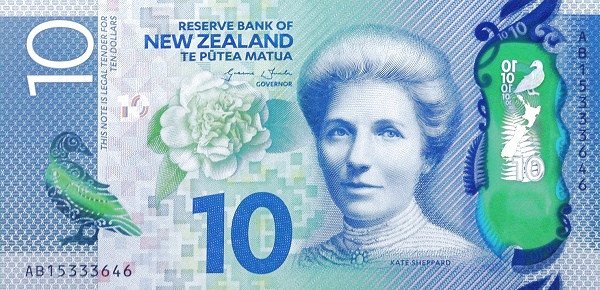NZD/USD Falls Close to 0.5700 as China’s Deflationary Pressures Hit Kiwi Sentiment
The NZD/USD currency pair fell close to the 0.5700 level in Monday’s Asian session, weighed down by worsening deflationary pressures in China. China’s Consumer Price Index (CPI) in February fell 0.7% year-over-year, the steepest decline since January 2024, fueling concerns over soft domestic demand in the world’s second-largest economy—New Zealand’s major trading partner. This has taken a heavy toll on the Kiwi. Yet, pair downside momentum can be curtailed by rising expectations of US interest rate cuts in light of weaker-than-expected Nonfarm Payrolls. The market waits now for Tuesday’s US CPI release for further cues on Fed policy and overall market direction. KEY LOOKOUTS • China’s sharper-than-expected decline in CPI signals weak domestic demand, adding pressure on the Kiwi from the strong trade links with China. • Markets await Tuesday’s US CPI data, which may impact Federal Reserve rate expectations and set the tone for NZD/USD action. • Soft US jobs data stokes rate cut speculation, which may cap USD strength and underpin a small NZD/USD rally. • International risk sentiment and geopolitics could affect safe-haven demand for USD, influencing near-term volatility in NZD/USD trading. The NZD/USD currency pair continues to be under pressure, trading close to the 0.5700 level in the wake of increasing deflationary pressures in China, New Zealand’s biggest trading partner. China’s CPI fall in February indicates poor consumer demand and puts additional bearish pressure on the Kiwi. Downside in the pair, however, may be capped as weaker US Nonfarm Payrolls data has reinforced expectations of future interest rate cuts by the Federal Reserve. Investors now look to Tuesday’s US CPI report, which will be instrumental in determining market sentiment and the short-term direction of the NZD/USD pair. NZD/USD hovers around 0.5700, weighed down by China’s worsening deflation and poor domestic demand. Downside is capped by weaker US jobs data, which enhances Fed rate cut hopes. All eyes now on Tuesday’s US CPI data for new direction. • NZD/USD quotes at 0.5700, weighed down by China’s emerging deflationary pressures. • China’s CPI dropped 0.7% in February, the largest fall since January 2024, indicating soft domestic demand. • New Zealand Dollar falls, as China is one of its key trading partners and economic slowdown dents Kiwi mood. • Soft US Nonfarm Payrolls data boosts expectations of several Fed interest rate cuts in 2024. • Fed policy direction continues to be prudent, with officials emphasizing caution and the requirement for data-driven decision-making. • US CPI releases on Tuesday are likely to be a major driver of the next direction in NZD/USD. • Market sentiment and global risk flows will continue to drive short-term currency pair movement. China’s increasing deflationary pressures have created new doubts about the strength of the world economy, particularly for nations such as New Zealand that enjoy strong trade relations with China. The steep drop in China’s Consumer Price Index (CPI) for February is an indicator of weak domestic consumption and weak household demand. As one of New Zealand’s largest export markets, any Chinese economic slowdown would tend to influence the Kiwi economy indirectly. Market players are becoming more cautious, observing how China’s domestic challenges may impact overall economic activity and global trade flows. NZD/USD Daily Price Chart Chart Source: TradingView Alternatively, the United States also has its own share of uncertainties, especially after the recent Nonfarm Payrolls reading indicated a moderation in job growth. This has promoted increasing speculation that the Federal Reserve will start cutting interest rates sooner rather than later. While policymakers have indicated a data-dependent policy, future economic indicators—particularly the US Consumer Price Index (CPI)—will have a crucial influence on forming expectations. These global macroeconomic trends are expected to drive investor sentiment and near-term policy choices in major economies. TECHNICAL ANALYSIS NZD/USD continues to come under bear pressure, trading near major support areas at the 0.5700 level. The pair has not been able to sustain buying momentum, reflecting that sellers still have the upper hand. A persistent break below this support level could pave the way for additional declines, but a bounce back above near-term resistance levels may reflect a potential change in mood. Traders will carefully observe price behavior around these major levels for reversal or breakout signals, particularly before high-impact economic releases such as the US CPI report. FORECAST If the coming economic data, specifically the US CPI, indicates softer inflation, this would reinforce expectations for Federal Reserve rate cuts and possibly weaken the US Dollar. This situation might present some upside potential for NZD/USD to recover to higher resistance levels. Moreover, any indication of policy stimulus or stabilization in China may enhance market sentiment for the Kiwi and present additional scope for recovery. Conversely, in the event that US inflation numbers turn higher than anticipated, this can temper expectations of premature rate reductions by the Fed, strengthening the US Dollar and putting additional pressure on NZD/USD. Additionally, ongoing deflationary indications and subdued Chinese domestic demand might further drain the New Zealand Dollar. In that scenario, the duo can find it difficult to stay above major support levels and might experience further falls in the near future.






